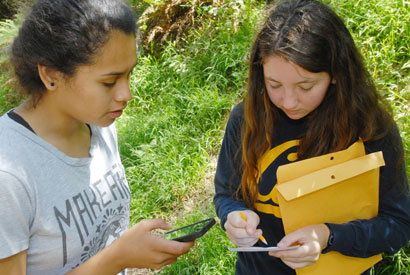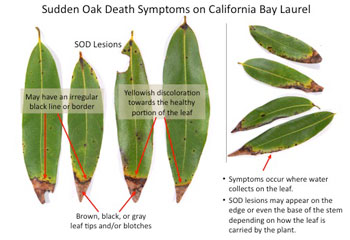
Two volunteers collect samples in the East Bay during the 2014 SOD Blitz. (Photo by Douglas Schmidt, UC Berkeley)
BERKELEY — Efforts to predict the emergence and spread of sudden oak death, an infectious tree-killing disease, have gotten a big boost from the work of grassroots volunteers.
A joint study reveals the power of citizen science in SOD Blitz, a survey project in which volunteers are trained to identify symptoms of sudden oak death. Led by Matteo Garbelotto at UC Berkeley and Ross Meentemeyer at North Carolina State University, the study was published today (Friday, May 1) in the journal Frontiers in Ecology and the Environment.
Sudden oak death is a fungus-like disease that has felled hundreds of thousands of trees in California. Crowdsourcing the survey and sampling work allowed researchers to gather information that would otherwise be too impractical and cost-prohibitive to obtain. Researchers then used the data to create a model that predicts the presence of the sudden oak death pathogen, Phytophthora ramorum, based upon such variables as rainfall and density of host trees.
Study authors compared the model based upon crowdsourced data gathered from the 2008-2013 blitzes with models using “pre-Blitz” research observations collected from 2000 to 2007. They found the SOD Blitz model to be more powerful, correctly predicting the presence of the pathogen 74 percent of the time, compared with models based on other sources of data.

This laminated card is given to SOD Blitz volunteers as part of a package with collection materials. The card helps citizen scientists correctly identify signs of SOD infection.
“This paper shows that volunteers are as proficient as professionals in collecting data after they get some initial training,” said study principal investigator Garbelotto, an adjunct professor and cooperative extension specialist at UC Berkeley’s Department of Environmental Science, Policy and Management. “The data we got from SOD Blitz resulted in the formulation of the best predictive model yet about the spread of sudden oak death in California. Additionally, we were able to identify new infestations and identify trees that needed to be removed. In one case, in Atherton, tree removal resulted in the only successful eradication of the pathogen in North America.”
The SOD Blitz model also revealed novel findings about the spread of the disease, finding that average population density and average maximum temperature were negatively correlated with the presence of the sudden oak death pathogen.
“The population density finding is important because of the debate about the role of humans in spreading sudden oak death disease,” said Garbelotto. “From this work we can say that humans are not currently spreading the disease, and that the pathogen is doing well spreading on its own.”
